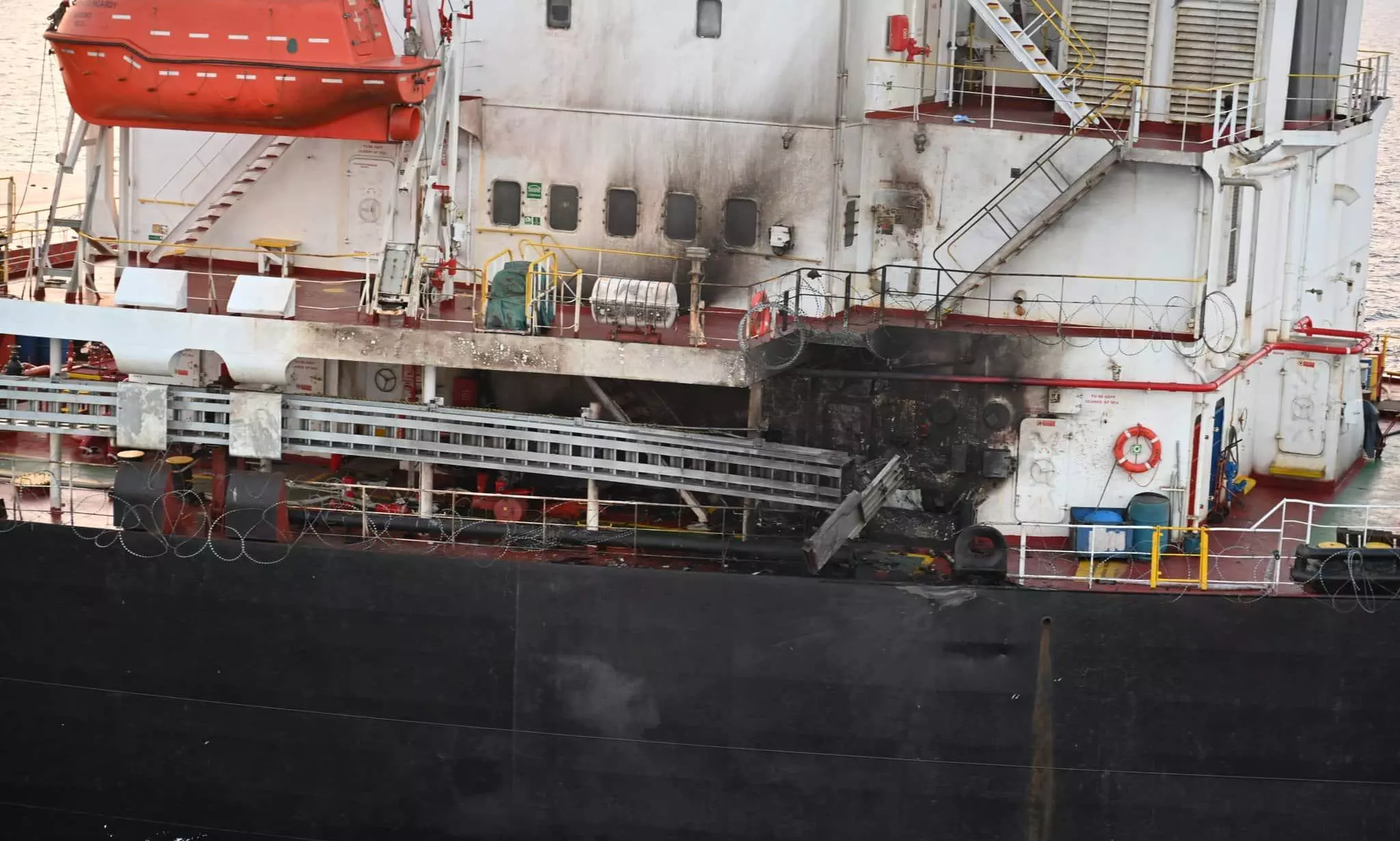US continues attacks against Houthis
Houthis continue to target merchant ships, ocean freight rates continue to rally on uncertainty

(MV Genco Picardy hit in Red Sea on January 17, 2024. Photo Credit: Indian Navy/X)
U.S. Central Command forces conducted strikes on January 19, 2024 against three Houthi anti-ship missiles that were aimed into the Southern Red Sea and were prepared to launch .
"U.S. forces identified the missiles in Houthi-controlled areas of Yemen and determined that they presented an imminent threat to merchant vessels and the U.S. Navy ships in the region," says an update on X.
U.S. forces subsequently struck and destroyed the missiles in self-defence. This action will make international waters safe and secure for U.S. navy vessels and merchant vessels, the update added.
United Kingdom Maritime Trade Operations (UKMTO), in its latest update, said it has received a report on January 18, 2024 of four unidentified uncrewed aerial systems (UAS) flying close to a merchant vessel 85NM South East of Ash Shihr, Yemen. Vessel reported one UAS hit the water approximately 800M from the vessel. "Vessel and crew are safe and proceeding to the next port of call."
Biden says attacks not working
U.S. President Joe Biden admitted that the attacks against Houthis "were not working."
"Are they gonna continue? Yes," Biden said, BBC reported.
U.S. President Joe Biden. Photo Credit: BBC
Abdul Malik al-Houthi, the leader of Houthis, "called it a great honour to be in direct confrontation with Israel, U.S. and U.K."
U.S. Central forces attacked 14 Iran-backed Houthi missiles that were loaded to be fired in Houthi controlled areas in Yemen on January 17, 2024.
General Michael Erik Kurilla, Commander, US Centcom says: "“The actions by the Iranian-backed Houthi terrorists continue to endanger international mariners and disrupt the commercial shipping lanes in the Southern Red Sea and adjacent waterways. We will continue to take actions to protect the lives of innocent mariners and we will always protect our people.”
Indian Navy acts
Indian Navy's Guided Missile Destroyer INS Visakhapatnam, deployed in Gulf of Aden for anti-piracy operations, responded to a distress call by Marshall Island-flagged MV Genco Picardy following a drone attack at 2311 hrs on January 17, 2024 and intercepted the MV at 0030 hrs on January 18, 24 to provide assistance.
"MV Genco Picardy with 22 crew (including nine Indians) reported nil casualties & fire under control," Indian Navy said in its update on X.
Duration of crisis unknown variable, says Drewry
Carriers are unlikely to resume Suez Canal transits until a time when the risk of attack has been eliminated, which seems more like months than weeks away, according to the latest assessment from Drewry.
"The duration of the crisis is the key unknown variable." In the best-case scenario, if trade starts to flow through Suez again shortly, the normal market dynamic will almost immediately snap back into play and prices will ebb, as too, sadly, will public interest in this fascinating sector, the update added.
"Suez Canal diversions will inflate container shipping costs for as long as the situation lasts but trade always finds a way, even if it takes a bit longer than usual," writes Simon Heaney, Senior Manager, Container Research, Drewry.
Drewry’s World Container Index (WCI) increased 23 percent to $3,777 per 40ft container for the week to January 18, 2024, and has increased 82 percent when compared with the same week last year.
"The latest Drewry WCI composite index of $3,777 per 40ft container is the highest since October 2022 and is 166 percent more than average 2019 (pre-pandemic) rates of $1,420."
Far East to Mediterranean rates zoom 157%: Xeneta
Spot rates from the Far East to the Mediterranean, a trade heavily affected by the Red Sea crisis, took another step upwards in mid-January, rising by $1,630 per FEU between January 14-18, 2024.
"This leaves the average spot rate at $6,050 per FEU, and 157 percent higher than a month ago," says the latest update from Xeneta.
Emily Stausbøll, Analyst, Xeneta says: "Rates have not yet hit anywhere near the levels we saw during Covid-19 but the sudden nature of the Red Sea crisis has brought delays and disruption much quicker than the early months of the pandemic. That means we have also seen a much more rapid increase in rates.”
Other trades also posting records
Between the Far East and North Europe, the average spot rate has increased by 181 percent from mid-December to $4,640 per FEU.
"Backhaul trades are also seeing increasing spot rates and spreads though not at the scale of fronthaul trades into Europe. Shippers on the backhaul trades are not facing the same capacity crunch with carriers under increasing pressure to get vessels back to the Far East before Lunar New Year."
Two different markets
Carriers and freight forwarders are pricing differently on a given shippers’ needs with two distinct groups forming, the update added.
"Many of the shippers securing rates at the lower end of the scale are doing so after their valid long-term contracts have been suspended and their supplier has pushed them to the spot market. Though their spend is still going up, they are not rising to the same extent as spot rates for shippers having to rely on FAK rates."
While some shippers are still able to keep shipping on agreed contracts, only some of the largest shippers are having success at avoiding extra surcharges being imposed by their suppliers.
The capacity crunch means carriers may have to pick and choose what containers to put on board a ship if it is full and will prioritise the most valuable customers and those paying the highest rates, the update added.



